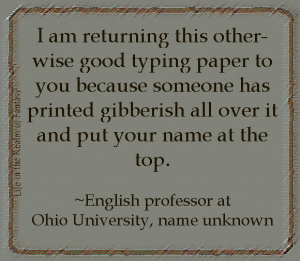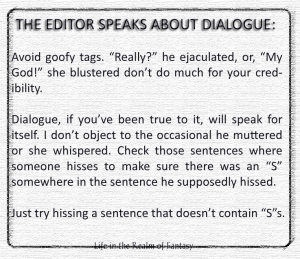 Dialogue can be tricky. Often, in our rush to get the ideas on paper, we have left off quotes, misplaced punctuation, and written interrupted dialogue with inconsistency.
Dialogue can be tricky. Often, in our rush to get the ideas on paper, we have left off quotes, misplaced punctuation, and written interrupted dialogue with inconsistency.
While a certain amount of literary license in dialogue can enrich our work, our dialogue may be too rich with run-on sentences, and not in a good way.
Also, while everyone has read books that inspire them to become writers, some authors never learned how to write the kind of dialogue they envision. They don’t understand the fundamentals and don’t realize how their lack of understanding ruins their work.
Always begin what is actually spoken (dialogue) with a capitalized word, no matter where in the sentence it begins.
- Mary glanced over her shoulder and said, “I’m sorry. I can’t go with you.”
However, interrupted dialogue, when it resumes, is not capped, although the rules of punctuation and quotation marks still apply.
- “I’m sorry to tell you,” said Mary, “but I can’t go with you.”
Direct dialogue is someone speaking to you or someone else and requires quotation marks.
- “I’m sorry. I can’t go with you,” said Mary.
I’m a US author, so I used double quotes, also called closed quotes. The UK usage is different and often uses apostrophes, or what they call inverted commas. Either way, be consistent and make sure ALL punctuation goes inside the quote marks.
Yes, I did say All punctuation. How does one set off a quote from someone else within dialogue? Set it apart with single quotes (apostrophes, inverted commas) and keep it inside the closed quotes.
George said, “When I asked her, Mary replied ‘I can’t go.’ But I’m sure she was lying.”
George said, “When I asked, Mary replied ‘I can’t go.'” Note there are 3 apostrophes there: 1 apostrophe and 1 double (closed) quote mark. This is in keeping with the rule that all punctuation in dialogue goes inside the quotation marks.
Indirect dialogue is a recapping of dialogue that someone previously spoke.
- When asked, George said Mary couldn’t go.
Note there are no quotes used in indirect dialogue. Also in this sentence, the word that is implied between said and Mary.
Dialogue tags, or attributions, can come before the dialogue, especially if you want the dialogue tag to be noticed. To make them less noticeable put them in the middle or at the end of sentences. In my own work, I want the dialogue and not the attribution to stand out. However, when more than two people are involved in a conversation, I move the dialogue tags further to the front so the reader isn’t left wondering who is speaking.
 I’ve mentioned before that I prefer simple attributions such as said, replied, and answered because they are not as likely to stop the reader’s eye. People don’t snort, smirk, smile, or frown dialogue as it is physically impossible. They can say it with a smile, but the smile is a facial expression and does not speak.
I’ve mentioned before that I prefer simple attributions such as said, replied, and answered because they are not as likely to stop the reader’s eye. People don’t snort, smirk, smile, or frown dialogue as it is physically impossible. They can say it with a smile, but the smile is a facial expression and does not speak.
Avoid verbal tics like “hmmm…” and “ahhh…” as they just take up space and add fluff to your narrative. When people in real life preface all of their sentences with drawn-out ahs and hmms it can be aggravating to listen to them. Consider how irritating it would be to read it.
Sometimes we have two ideas in a sentence that we think are one, and we connect them with commas. But closer examination shows they are not.
- “Hello, sir, we bathed your dog,” she said.
The above dialogue contains a run-on sentence, despite its shortness. We may actually speak it in this fashion, words run together, but for a reader, punctuation clarifies ideas.
The dialogue contains two separate ideas. “Hello, sir,” is an acknowledgment and a greeting. “We bathed your dog,” indicates an action was taken in regard to his dog. It should be:
- “Hello, sir. We bathed your dog,” she said.
- When we write our conversation using proper punctuation, it looks natural, and the reader will hear it the way it was intended.
When it’s done right, dialogue is, in my opinion, the best part of the story. It’s where we discover who the characters are, and how the larger events affect them. Conversations show the world as the protagonist sees it. We can take some style and voice liberties with dialogue, and indeed, we should, but adhering to industry standard rules of punctuation ensures your reader can remain immersed in the story, and forget they are reading.
And THAT is what we all hope for.








“Alas, it may yet prove rather futile,” lamented the English professor, “for though I give them printed examples and point out each variation of the pattern, few subsequently reproduce the proper pattern even though all they need do is look and copy, look and copy–yet do they?” He pulled out several bunches of hair from his head. “And that is the reason I am going bald!”
LikeLiked by 4 people
@Professor—Aw! {{{hug}}} If they become writers, they will remember what you taught. Not everyone is cut out for the job.
LikeLike
Excellent writing lesson. In fiction, of course, there are options. Whether to use quote marks or dashes or neither, for instance. Whether tis nobler to write in fragments, or not. For instance. But, in the main, I ask that my students observe correct use of dialogue punctuation, until they demonstrate they can break the rules knowingly.
LikeLiked by 1 person
@Scott–thank you. I am learning as I go. I have a tendency to overuse em dashes and fragments in my own work, so my task right now is weeding eye-stoppers out, and leaving the personality in.
LikeLike
Pingback: Tips for writing clear dialogue by Connie Jasperson | Daily Echo
Reblogged this on Chris The Story Reading Ape's Blog and commented:
In case anyone missed this great post by Connie 😀
LikeLiked by 1 person
Thank you, Chris!
LikeLiked by 1 person
Welcome Connie – Great post 😀
LikeLike
Succinct and yet instructional. Well done, thanks!
LikeLike
@Deborah–thank you.
LikeLiked by 1 person
You are very welcome!
LikeLike
Very helpful suggestions. I find quotation mark usage confusing so it’s good to have rules to review.
LikeLike
@Deanie–I try to keep it simple because at times they can be confusing. But the more you work with these rules, the more they become habits that translate into all your work.
LikeLike
Reblogged this on deanieblog.
LikeLiked by 1 person
Excellent reminders. 🙂
LikeLike
Thank you 🙂
LikeLike
I wish everyone go through this post. 🙂 I’m tired of seeing punctuation errors…
LikeLiked by 1 person
@Maniparna–it’s true that many of us, myself included, have forgotten much of what we were taught. I think it’s one of those ‘use it or lose it’ skills.
LikeLiked by 1 person
A review of what we should all remember from our school days, is always welcome.
LikeLiked by 1 person
This is what good editors are for 🙂 Grammar was never my strong point. Loved the Ohio professor’s comment.
LikeLike
@Fiona–Nice to meet you. While I was good at grammar in some ways, my education was many years ago. I had to relearn many things, and have been fortunate to have access to the tools I need for doing just that. I have a fondness for the professor too–his students are fortunate to have him as his instructor.
LikeLike